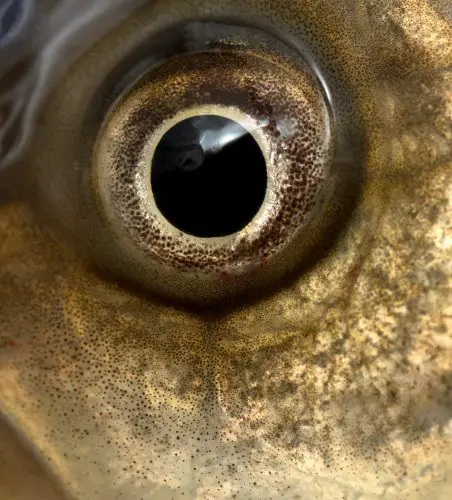The pressure of the swim bladder’s gasses is identical at depth. The gasses can cause the eyes to enlarge and become opaque or crystalline. It also causes the stomach to protrude out of the mouth when the grouper goes up to the surface. It causes barotrauma, a variety of injuries that almost always result in the fish’s death when it is unable to get rid of the gas as it surfaces. Groupers swim bladders would normally regulate this as the go up and down in the water. However, if they are reeled in too fast it could cause the eyes to pop out.
What is Barotrauma?
Injury caused by pressure is known as barotrauma. Grouper can regulate buoyancy and retain depth in the water column. It’s reeled in and brought to the surface. Its inability to expel expanding gasses from its swim bladder results in barotrauma. The eyes, stomach, or vent may appear blown up or noticeably expanded for barotrauma injuries. The severity of barotrauma injuries differs between species as their swim bladders function at various depths and pressures.

What injuries?
The stomach of grouper may protrude from its mouth with enlarged eyes, a bloated abdomen, bubbling scales, and swollen intestines. Fish with barotrauma may exhibit signs including protruding intestines, enlarged eyes, bloated stomachs, and stomachs pushed out through the mouth. Some fish may not appear to have barotrauma, but they still might have died from internal injuries such as a ruptured swim bladder, organ damage, internal bleeding, or blood clotting.
Why does it affect grouper?
Many fish suffering barotrauma that initially glances appears to be dead can live! Studies using long-term tags reveal that fish that are immediately re-pressurized and eventually released at the bottom (even in deep water!) have a high survival rate. Descending mechanisms are excellent for returning “floaters” to the bottom.
When do fish experience barotrauma?
Although barotrauma takes place at depths of 50 feet or more, depending on the species captured, it can sometimes occur at shorter depths. Gasses in the body cavity and internal organs swell as fish are pulled up from deep water, frequently dislodging the organs and leaving the animal swollen.
What To Do to Help a Fish with Barotrauma
There are two approaches to aid fish who have undergone barotrauma. Venting allows the fish to independently return to depth by releasing the gas accumulated inside the swim bladder, and through weighted descent, fish return quickly to capture depth.
Swift working is crucial whenever releasing fish. A fish’s chances of survival increase with the speed of return to the ocean. Use equipment that reduces battle time to lessen lactic acid buildup and stress, and utilize your board time effectively to ensure speedy release to the water. The longer a fish remains at the surface, the more severely it suffers from barotrauma.
Venting
One of the traditional barotrauma mitigation techniques is venting. It works best when you need to handle a lot of fish quickly. According to data, most fish caught at depths less than 125 feet recover rapidly and resume their normal behaviors in 24 to 48 hours.
Venting is releasing the gas that swells inside the swim bladder during ascent. A sharp, hollow device is introduced into the muscle to pierce the swim bladder wall. Tools for venting come in a wide variety. You can also create your own using any pointed and hollow object. Knives and ice picks are inappropriate since they don’t offer enough room for the gas to escape.
Lay the fish on its side to adequately vent (on a cool or wet surface). Place the venting devices at a 45-degree angle under a scale at the pectoral fin’s trailing edge, just deep enough to release the swim bladder’s trapped gas. Make sure not to put a venting tool into the belly or back if the stomach is sticking out of its mouth.
Pros
- Fast and especially useful in circumstances requiring swift handling of many fish.
- When carried out properly, it increases the survival rate of fish.
Cons
- Any sharp object poses a risk of puncture to you and the fish.
- According to research, roughly 50% of fishermen vent inappropriately, which causes the fish to be hurt or killed.
Weighted Descent
While descending, a fish gets sunk by being enclosed in or attached to a weighted apparatus. Recompressing the fish’s inflated gas inside will allow it to regain its natural buoyancy and swim away when it is brought back to depth on a weight. The three main categories of devices are fish elevators, inverted hooks, and mouth grips.
Mouth grips are attached to a rod and reel or hand line and clamp to the fish’s mouth. Then use a pressure-sensor release mechanism that automatically releases the fish at a specified level chosen by the angler, or you can use a heavy spring method to set free fish when you give the line a hard tug or when the weight touches the bottom.
Inverted hooks get placed via the hole the holder makes and function similarly to mouth grips. A few quick jerks on the line from the fisherman cause the fish to release the inverted clip once it has descended sufficiently far to reverse the effects of barotrauma.
Then comes the fish “elevator,” which uses an inverted container like a milk box with weights on the bottom and a rope fastened to the top. Fish are drawn back down to depth by the bottomless cage this creates. The fish can swim out of the bottom of the container by itself once it has decompressed.
Among fishermen, the following weighted descent concerns are typical:
- Fish will flee if gear descends.
- The fish and the tool attract predators.
- The use of the descending gearwheel is challenging and time-consuming.
However, some descending equipment is very straightforward, and there is little indication of lowered catchability or elevated predation. However, because every circumstance is unique, some fishermen might face various challenges based on their surroundings and circumstances.
Pros
- A non-invasive method lessens injury
- No sharp objects are necessary.
- Simple to learn
- Reduce the risk of predation by swiftly returning groupers to the bottom where some live.
Cons
- More equipment takes up room on the boat
- Pricey compared to venting tools
- Pulling the weighted equipment up to the surface takes more time.
- Every fishing tool does not function in every circumstance.
Why Help Fish With Barotrauma?
To improve the survival rates of released fish, recreational grouper fishing, commercial fishing operations, and fisheries managers encourage the adoption of barotrauma mitigation measures. Regulations requiring the release of fish are only effective if fish survive. Future fishing opportunities may increase if discard mortality decreases.
Careful Handling Points
- The fish might survive if it returns to the ocean quickly.
- To lessen the stress on the fish, choose equipment that cuts down on combat time.
- With tools for dehooking and barotrauma ready to use, you can handle fish rapidly on deck.
- To offer the fish the chance of surviving, use barotrauma equipment effectively.
- Reduce the time when fish get exposed to predators at the surface or in open water.











